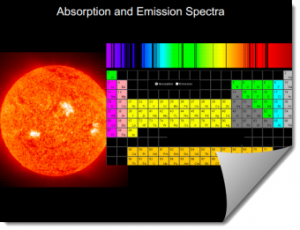The Mystery of the Sun: Difference between revisions
(Created page with "{{ResourcePageGroupMenu|Astronomy - presentations}} Category:Science {{ResourceMenu}} {{Rinfo |final= |title=The Mystery of the Sun |topic=Astronomy |subject=Science |tagl...") |
m (subjects, ages, types) |
||
| (3 intermediate revisions by 2 users not shown) | |||
| Line 1: | Line 1: | ||
{{ResourcePageGroupMenu|Astronomy - presentations}} | {{ResourcePageGroupMenu|Astronomy - presentations}} | ||
[[Category:Science]] | [[Category:Science]] | ||
{{Rinfo | {{Rinfo | ||
|type= Lesson idea | |||
|attribution={{Chris Tooley}} | |||
|final= | |final= | ||
|title=The Mystery of the Sun | |title=The Mystery of the Sun | ||
|topic=Astronomy | |topic=Astronomy | ||
|subject=Science | |subject=Science | ||
|tagline= | |tagline=How can we tell what the sun is made from? What can light from the stars tell us? | ||
|image= | |image=Mysteryofthesun1.png | ||
|resourcenumber= SC0037 | |resourcenumber= SC0037 | ||
|Learning Objectives= | |Learning Objectives= | ||
* | * explain how we use absorption and emission spectra to identify the chemical makeup and nature of stars | ||
* | * use the Bohr model of the atom to explain how emission and absorption spectra are formed | ||
|age=Secondary | |age=Secondary | ||
|content= | |content=As this slide presentation explains in more detail, we can tell what the sun is made from by the light wavelengths that we see emitted and absorbed. The presentation includes video and in an accompanying audio file, the teacher explains what it aims to do. See other titles in this series to appreciate the 'active note taking' which normally accompanies this lesson. | ||
|format= | |format= | ||
|strategy= | |strategy= | ||
| Line 24: | Line 24: | ||
|other= | |other= | ||
|resources= | |resources= | ||
* Smartboard notebook | * Teacher's audio explanation of how the lesson was delivered [[media:CT - Mystery of the Sun voiceover.MP3]] | ||
* Powerpoint version:[[ ]] | The presentation has been converted to alternative formats: | ||
* PDF | * Smartboard notebook version [[File:The Mystery of the Sun.notebook]] | ||
* Powerpoint version:[[File:]] | |||
* PDF version [File:SC0037 The mystery of the sun.pdf]] | |||
}} | }} | ||
Latest revision as of 15:51, 28 September 2012
Astronomy - presentations
[[|<<<]]
[[|>>>]]
This resource may not be final.
Lesson idea. As this slide presentation explains in more detail, we can tell what the sun is made from by the light wavelengths that we see emitted and absorbed. The presentation includes video and in an accompanying audio file, the teacher explains what it aims to do. See other titles in this series to appreciate the 'active note taking' which normally accompanies this lesson.
Teaching approach. The lesson model is that of active note-making. Students are provided with mini-diagrams* around which they build up personalised notes about the lesson. Students must not take notes from the board but instead must use their creativity to develop their own notes. They are encouraged to use colour, image, symbols, humour and metaphor to lead them through a richer learning experience. Students need help in achieving this but soon catch onto the idea. They become more independent with taking notes and more attentive to the subject at hand. (edit)
| Resource details | |
| Title | The Mystery of the Sun |
| Topic | |
| Teaching approach | |
| Learning Objectives |
|
| Format / structure | |
| Subject | |
| Age of students / grade | |
| Table of contents | |
| Additional Resources/material needed | |
| Useful information | |
| Related ORBIT Wiki Resources | |
| Other (e.g. time frame) | |
| Files and resources to view and download |
The presentation has been converted to alternative formats:
|
| Acknowledgement | |
| License | |

